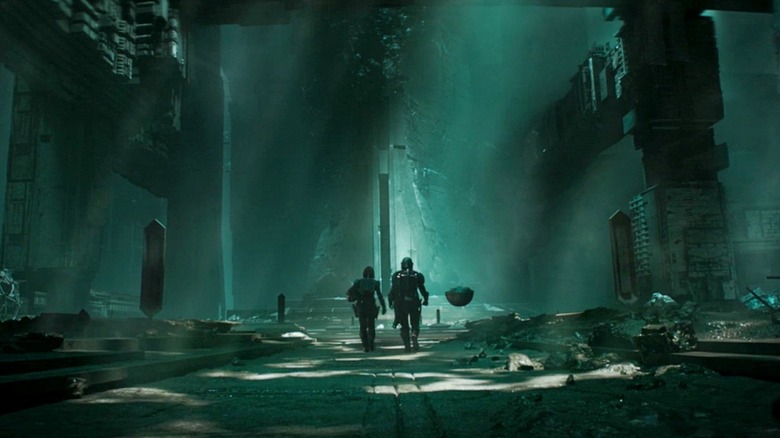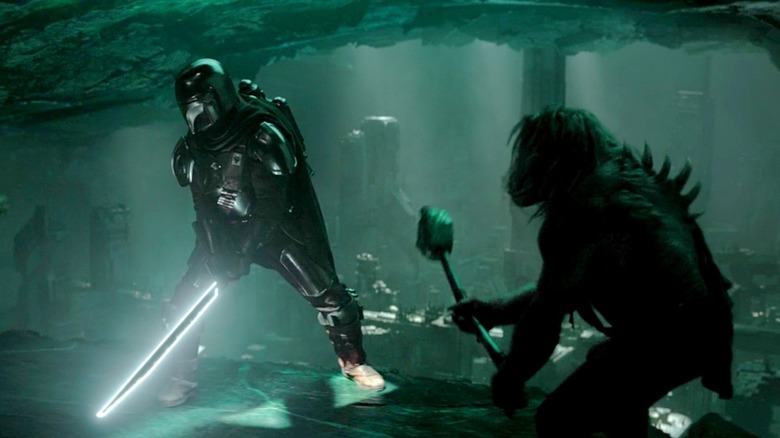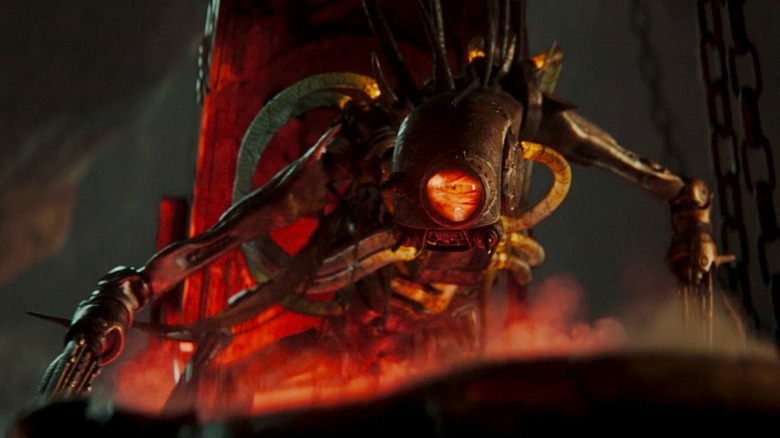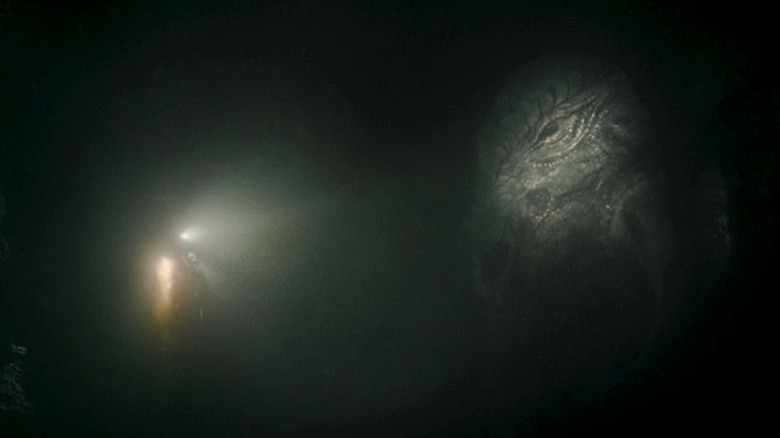The Mandalorian Season 3 Goes Full Lord Of The Rings With Its Second Episode
Warning: This article contains major spoilers for the second episode of "The Mandalorian" season 3.
"Star Wars" has never been shy about its influences. Most famously, George Lucas made no attempts to hide the fact that he borrowed heavily from Akira Kurosawa and old-school "Flash Gordon" serials for the original trilogy. "Rogue One," as another example, leaned heavily into its trappings as a war movie to depict a rarely-seen, ground-level perspective on the epic galactic struggle between the Rebellion and the Empire. And even shows like "The Mandalorian" have worn their inspirations on their sleeve, as in the season 2 episode "The Passenger" that took its cues from "Alien" and "Predator" and plunged the series into horror.
Season 3 of "The Mandalorian" got off to a relatively slow and subdued start last week, but this latest episode kicked the story into a higher gear — and evoked yet another pop culture touchstone in the process. After consulting with the Armorer (Emily Swallow), Din Djarin (Pedro Pascal) visits the abandoned world of Mandalore in order to atone for his sins by finding the "Living Waters" hidden deep underground. Of all of the bounty hunter's past adventures, this proves to be one of his toughest challenges. The wrecked planet has long been considered "cursed," with its atmosphere rendered completely unbreathable. But most of all, actually finding the hidden locale poses the largest obstacle as Mando and Grogu must traverse through (and survive) the Mines of Mandalore first.
Along the way, director Rachel Morrison and episode writer (and series creator) Jon Favreau fill the hour with set dressing, enemies, and a melancholy tone that strongly parallels the Mines of Moria sequence from "The Lord of the Rings: The Fellowship of the Ring." As a result, this feels like one of the show's most memorable episodes yet.
'And they call it a mine...'
Dear sci-fi and fantasy characters: If your quest requires you to travel to a once-thriving realm that has since been abandoned after a horrific attack by swarms of enemies and now takes the form of a desolate mining city long past its prime, well, you should probably keep your distance. Both Mando and the members of the Fellowship of the Ring learned this lesson the hard way in their respective adventures.
In "The Lord of the Rings," the Fellowship sets out on a treacherous path into the ancient Dwarven realm of Moria, giving audiences a hands-on crash course in the history and world-building of Middle-earth. "The Mandalorian" pulls a similar trick in this latest episode, finally paying off on countless references to the Mandalorian home world and plunging headfirst into the single most traumatic event experienced by the entire population. Much as the Dwarves in author J.R.R. Tolkien's universe found wealth and power through the mining of Mithril ore, Mando's people have historically mined Beskar ore as an integral part of their cultural identity. Now, however, both of the famous locations are merely the subject of suspicious whispers and rumors, spoken of in low tones in unspoken fear of the threats that may reside there.
Under the confident direction of Morrison (who has had experience as an acclaimed cinematographer in the past), the visuals of the now-destroyed Mandalore strongly call to mind the empty and oppressively dark ruins of Moria. Once a prosperous hub of an entire race of people, reckless visitors in the present can only gaze at the crumbling relics surrounding them and imagine what they must have been like at their peak. And in another remarkable similarity, both Mandalore and Moria were brought low by shocking defeats.
'They have a cave troll'
Concept artists, set designers, VFX artists, and more can all pool their resources and come up with the most striking locations ever depicted on-screen, but even such gargantuan efforts will be in vain without a tangible threat posed to our heroes. When Mando and Grogu venture into the deepest and darkest parts of the Mines of Mandalore, they quickly run afoul of a savage and unfriendly group of beings that instantly feel like the "Star Wars" equivalent of orcs and goblins — ones who, as Bo-Katan (Katee Sackhoff) casually remarks later on, would've happily eaten them if given the opportunity. Undeterred, Din Djarin presses on and comes across the disturbing imagery of a half-buried Mandalorian helmet; again, this can't help but bring to mind the Dwarf Gimli (John Rhys-Davies) and the Fellowship stumbling across the corpses and armor of countless slain Dwarves in Moria.
But none of this compares to the scarier villain hidden deeper within.
Much as the Fellowship triggers an attack by legions of goblins and their formidable cave troll, Mando unsuspectingly falls into the trap laid by a terrifying, bio-mechanical droid in the episode's climactic boss fight. Although the repetitive nature of the script sucks some of the tension out of this sequence (did we really need to see the step-by-step process of Grogu retracing his steps and bringing Bo-Katan back? Why not just have her follow them there in the first place?), the rescue attempt that follows at least delivers all the requisite thrills. Though not nearly as prolonged or tense as the tomb sequence in "Fellowship," it's undeniable that seeing "The Mandalorian" attempt to capture a similar sort of magic helps elevate this episode as an early, difficult-to-be-topped highlight of the season.
'A demon of the ancient world'
What sci-fi/fantasy franchise would feel complete without the overarching presence of mythological beasts far beyond the understanding of mere mortals? This is perhaps the most impressive (if brief) parallel that "The Mandalorian" draws with "The Fellowship of the Ring."
Before Frodo and the rest of our heroes ever even enter the Mines of Moria, Gandalf is plagued by the knowledge of what may very well await them inside: a fiery Balrog, a "demon" of the ancient world that was awakened by the Dwarves and subsequently laid waste to their mighty realm. While the exact circumstances of Mandalore's destruction differ — as explained in "The Book of Boba Fett" and in this episode, the armadas of the dastardly Empire descended upon Mandalore like an iron fist — episode 2 gives fans a glimpse of the quasi-religious fervor placed upon a certain creature in Mandalorian culture.
When Mando, Grogu, and Bo-Katan reach the mystical Living Waters (which, uh, don't look all that "living" these days), Bo-Katan finds an ancient tablet and reads the words laid down from a long-dead Mandalorian describing the mines as a former "Mythosaur lair" — not too dissimilar from when Gandalf does the same in the tomb, actually, as he reads from the decaying book that hints at their impending doom. Mando, of course, strolls right into the water and nearly drowns, saved only by the quick-thinking Bo-Katan ... but while she's rescuing him from the chilly depths, she briefly comes face-to-face with a still-living Mythosaur. One may be fire and one may be water-based, but this certainly feels like the show's version of a Balrog.
Here, "The Mandalorian" finds its most potent echo of "The Lord of the Rings" yet.
New episodes of "The Mandalorian" stream on Disney+ every Wednesday.



